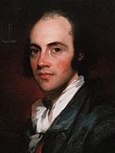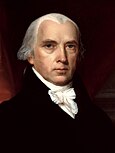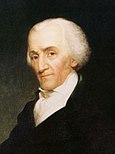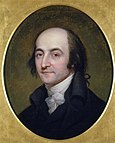This is a list of Democratic-Republican Party candidates for the offices of President of the United States and Vice President of the United States. Opponents who received over one percent of the popular vote or ran an official campaign that received Electoral College votes are listed. Offices held prior to Election Day are included, and those held on Election Day have an italicized end date.
List of Democratic-Republican tickets
1792
| Presidential nominee |
1792 (lost) | Vice presidential nominee | |
|---|---|---|---|
| None |
|
George Clinton of NY (1739–1812) 
| |
| Opponent(s) George Washington (Independent) |
|
Opponent(s) John Adams (Independent) | |
1796, 1800, 1804
| Presidential nominee |
1796 (lost), 1800 (won), 1804 (won) | Vice presidential nominee | |
|---|---|---|---|
| Thomas Jefferson of VA (1743–1826) 
|
|
|
Aaron Burr of NY (1756–1836)  (1796, 1800) |
|
George Clinton of NY (1739–1812)  (1804) | ||
| Opponent(s) John Adams (Federalist) |
|
Opponent(s) Thomas Pinckney (Federalist) | |
|
Opponent(s) Charles Pinckney (Federalist) | ||
| Opponent(s) Charles Pinckney (Federalist) |
|
Opponent(s) Rufus King (Federalist) | |
1808, 1812
| Presidential nominee |
1808 (won), 1812 (won) | Vice presidential nominee | |
|---|---|---|---|
| James Madison of VA (1751–1836) 
|
|
|
George Clinton of NY (1739–1812)  (1808) |
|
Elbridge Gerry of MA (1744–1814)  (1812) | ||
| Opponent(s) Charles Pinckney (Federalist) |
|
Opponent(s) Rufus King (Federalist) | |
| Opponent(s) DeWitt Clinton (Federalist) |
|
Opponent(s) Jared Ingersoll (Federalist) | |
1816, 1820
| Presidential nominee |
1816 (won), 1820 (won) | Vice presidential nominee | |
|---|---|---|---|
| James Monroe of VA (1758–1831) 
|
|
|
Daniel Tompkins of NY (1774–1825) 
|
| Opponent(s) Rufus King (Federalist) |
|
Opponent(s) John Howard (Federalist) | |
| Opponent(s) None |
|
Opponent(s) Richard Stockton (Federalist) | |
1824
| Presidential nominee |
1824 (won) | Vice presidential nominee | |
|---|---|---|---|
| John Quincy Adams of MA (1767–1848) 
|
|
|
John C. Calhoun of SC (1782–1850) 
|
| Andrew Jackson of TN (1767–1845) 
|
| ||
| William Crawford of GA (1772–1834) 
|
|
|
Albert Gallatin of PA (1761–1849) 
|
|
Nathaniel Macon of NC (1757–1837) 
| ||
| Henry Clay of KY (1777–1852) 
|
|
|
Nathan Sanford of NY (1777–1838) 
|
| Opponent(s) None |
|
Opponent(s) None | |
Other candidates
See also: List of people who received an electoral vote in the United States Electoral CollegeIn addition to the individuals listed above, other Democratic-Republicans received electoral votes between 1792 and 1824. In the 1792 election, George Washington effectively ran unopposed for president, but the nascent Democratic-Republican Party attempted to defeat Vice President John Adams's bid for re-election through the candidacy of George Clinton. Thomas Jefferson and Aaron Burr also received votes in that election. In the 1796 election, Clinton, Samuel Adams, and John Henry each received votes. In the 1808 election, John Langdon, James Madison, and James Monroe all received votes for vice president, while Clinton received a small number of votes for president. In the 1824 election, Martin Van Buren received nine electoral votes for vice president. During that same election, the Democratic-Republican congressional nominating caucus nominated a ticket consisting of William H. Crawford and former Secretary of the Treasury Albert Gallatin, but Gallatin ultimately withdrew from the race.
In the 1812 election, Madison's main opponent, DeWitt Clinton, was nominated for president by a legislative caucus of New York Democratic-Republicans. The Federalist Party did not officially nominate Clinton, but most Federalist leaders tacitly supported Clinton's candidacy in hopes of defeating Madison.
Notes
- The Democratic-Republicans did not nominate a presidential nominee in 1792.
- Prior to the ratification of the Twelfth Amendment in 1804, each member of the Electoral College cast two votes, with no distinction made between votes for president and votes for vice president. The Democratic-Republicans may or may not have officially nominated Jefferson for president through a congressional nominating caucus, but Jefferson was widely regarded as the party's main presidential candidate in the 1796 election. The Democratic-Republicans did not select an official vice presidential candidate. Aaron Burr finished with the second-most electoral votes among individuals affiliated with the party. Because Jefferson won more electoral votes than the second Federalist candidate, Thomas Pinckney, he was elected as vice president.
- The Democratic-Republican Party was unable to unite behind a single candidate in 1824. Four Democratic-Republicans received electoral votes in the general election, and, as no candidate won a majority of the electoral vote, the election was decided in a contingent election held in the House of Representatives. John Quincy Adams won that contingent election. Most presidential electors who voted for either Adams or Jackson for president voted for John C. Calhoun for vice president. Similarly, most electors who cast their presidential vote for Clay cast their vice presidential vote for Nathaniel Macon, and most electors who cast their presidential vote for Crawford cast their vice presidential vote for Nathan Sanford.
- Gallatin was nominated by the party's congressional caucus and withdrew in favor of Macon.
References
- ^ "Electoral College Box Scores 1789–1996". National Archives and Records Administration. Retrieved 16 September 2018.
- ^ "United States Presidential Election Results". Dave Leip's Atlas of U.S. Presidential Elections. Retrieved 16 September 2018.
- Morgan (1969), pp. 185–186
- ^ If not for a three electors dying prior to the Electoral College convening and not being replaced, Monroe would have received 234 votes (99.6%).
- If not for a three electors dying prior to the Electoral College convening and not being replaced, Tompkins would have received 221 votes (94.0%).
- Morgan (1969), p. 195
- Thompson (1980), pp. 174–175
- Walters (1957), pp. 320–324
- Siry (1985), pp. 457–460
Works cited
- Morgan, William G. (1969). "The Origin and Development of the Congressional Nominating Caucus". Proceedings of the American Philosophical Society. 113 (2): 184–196. JSTOR 985965.
- Siry, Steven Edwin (1985). "The Sectional Politics of "Practical Republicanism": De Witt Clinton's Presidential Bid, 1810–1812". Journal of the Early Republic. 5 (4): 441–462. JSTOR 3123061.
- Walters, Raymond Jr. (1957). Albert Gallatin: Jeffersonian Financier and Diplomat. Macmillan. ISBN 978-0-8229-5210-7.
| Lists related to presidents and vice presidents of the United States | |||||||
|---|---|---|---|---|---|---|---|
| Presidents |
| ||||||
| Vice presidents | |||||||
| Succession | |||||||
| Elections | |||||||
| Candidates |
| ||||||
| National political parties in the United States | |||||
|---|---|---|---|---|---|
| List of political parties in the United States | |||||
| Major parties | |||||
| Third parties |
| ||||
| Defunct parties |
| ||||
| State and local political parties without a federal or national parent body | ||||||||||||||||||||||||||||
| State parties |
|  | ||||||||||||||||||||||||||
| Local parties |
| |||||||||||||||||||||||||||
| Territorial parties |
| |||||||||||||||||||||||||||
| National political parties in the United States | ||||||||||||||||||||||||||||